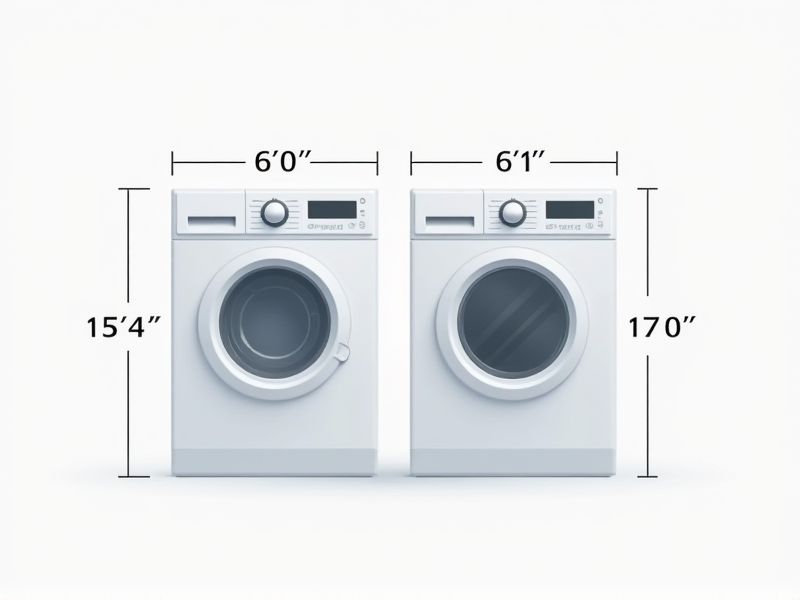
When shopping for washers and dryers, it's helpful to know the standard dimensions to ensure they fit your laundry space. Most full-size washers and dryers are about 27 inches wide, 30-34 inches deep, and between 38 and 43 inches tall. Keep in mind that you'll need extra space behind the appliances for hookups and ventilation, so adding 4-6 inches to the depth measurement is wise. Measuring your available area beforehand and comparing it to the product specifications can save you time and prevent installation headaches.
Capacity
The capacity of a washer and dryer is a crucial factor to consider, typically ranging from 3.5 to 5.5 cubic feet for washing machines and 5.5 to 9.0 cubic feet for dryers. A larger capacity can accommodate larger loads, allowing you to do laundry less frequently, which can save both time and energy. For households with multiple members or those who wash bulky items like comforters, models with capacities exceeding 4.5 cubic feet are often recommended. Understanding your laundry needs can help you choose an appliance that optimally supports your lifestyle.
Dimensions (Height, Width, Depth)
Washer and dryer dimensions significantly impact your laundry room design and functionality. A standard washing machine typically measures between 27 to 30 inches in width, approximately 36 inches in height, and 25 to 34 inches in depth. Dryers often have similar dimensions, with most brands' width and height closely aligned with that of washers, ensuring a seamless fit in stacked or side-by-side configurations. When selecting your appliances, consider the specific dimensions of your space, including doorways and ventilation requirements, to ensure proper installation and use.
Door Opening Type
When selecting a washer and dryer, one key factor to consider is the door opening type, which significantly affects convenience and space utilization. Front-loading machines typically feature a door that swings open from the front, allowing for efficient stacking and easily accessible loading and unloading, while top-loading machines open from the top, providing ergonomic access without bending over. For instance, front-loaders have become increasingly popular, representing over 65% of the market share in recent years due to their energy efficiency and superior cleaning capabilities. You should also measure the available space in your laundry room, as door opening type can influence the overall footprint and accessibility of your appliances.
Stackable Options
Stackable washers and dryers are designed to maximize space efficiency, ideal for compact living environments. Typically, these units measure around 27 inches wide and can fit comfortably in closets or small laundry rooms. Many models offer a combined load capacity of 3.5 to 5 cubic feet, ensuring you can wash and dry ample laundry at once. When considering stackable options, check for features like energy efficiency ratings, which can save you approximately 20-30% on utility bills compared to traditional setups.
Venting Requirements
Washer and dryer venting requirements are critical for optimal performance and safety. Most manufacturers recommend a maximum vent length of 25 feet for efficient airflow, with specific bends that should not exceed 90 degrees. Proper vent sizing, typically a 4-inch diameter, is essential to prevent lint buildup and enhance drying efficiency, while materials like rigid aluminum ducting ensure durability. Regular inspections and cleanings of the venting system can reduce fire risks and improve appliance longevity, making it crucial for you to maintain these standards.
Installation Space Needed
The standard installation space needed for a washer and dryer typically measures 5 to 7 square feet, accommodating both appliances side by side. When planning your laundry room, ensure there's a minimum width of 30 inches for each unit, with a depth of 30 to 32 inches to allow for ventilation and accessibility. A clearance of at least 1 inch on the sides and back is ideal for proper airflow and maintenance ease. Always consider additional space for utility connections, door swings, and folding areas, enhancing your overall laundry experience.
Electrical Requirements
The standard electrical requirements for washers and dryers typically include a voltage rating of 240 volts for most electric dryers and 120 volts for washers. Washers generally require a dedicated circuit of 15-20 amps, while electric dryers must be connected to a 30-amp circuit for optimal performance. It's crucial that your laundry room has adequate wiring and outlets to support these appliances, ensuring safety and efficiency. Failure to meet these electrical standards can lead to potential hazards, including tripped breakers or appliance malfunctions.
Water Connection Requirements
Washer and dryer units typically require specific water connection standards to ensure optimal performance. For washing machines, a cold and hot water supply is essential, with a recommended pressure of 20-120 psi for efficient operation. When installing, ensure that the hoses are at least 5/16 inches in diameter to accommodate proper water flow. Your laundry setup should also have a drain that can handle at least 17 gallons per minute to prevent overflow and flooding.
Noise Levels
Noise levels in washers and dryers are crucial for maintaining a peaceful home environment. The average noise level of a front-load washer ranges from 50 to 60 decibels, comparable to a normal conversation, while top-load models can reach up to 70 decibels. Many modern machines feature sound-dampening technologies and inverter motors designed to reduce vibrations during cycles. When selecting a unit, consider models with noise-reducing ratings for a quieter laundry experience, enhancing your household comfort.
Energy Efficiency Ratings
Energy Efficiency Ratings for washers and dryers play a crucial role in sustainability and cost savings. A high Energy Star rating can reduce energy consumption by about 20-30%, leading to significant savings on utility bills over time. Many modern models use advanced technologies, such as moisture sensors, which optimize drying cycles and minimize energy use, saving you money. Look for appliances with lower kilowatt-hour (kWh) usage per cycle to maximize efficiency and eco-friendliness in your laundry routine.
